Aviation Weather - Block III
1/95
There's no tags or description
Looks like no tags are added yet.
Name | Mastery | Learn | Test | Matching | Spaced |
|---|
No study sessions yet.
96 Terms
What conditions promote the best growth of thermal circulations?
When a colder airmass moves over warmer land
During the day, under clear skies and in warmer months
What is the most clear indication of quickly moving, rising air?
A towering cumulus cloud
T/F - Both dust devils and thermals develop a distinct circulation
FALSE
The upper limit of convective clouds depends on presence or absence of ______ layers above the CCL. Additionally, limited cloud growth occurs in the cold airmass behind a _______ front
The upper limit of convective clouds depends on presence or absence of stable layers above the CCL. Additionally, limited cloud growth occurs in the cold airmass behind a cold front
Above the convective condensation level air cools at
A variable rate
The saturated adiabatic lapse rate
What is included in a complete definition of cloudy convection
The upward movement of saturated air that is warmer than its surroundings
Saturated air that descends because it is colder than its surroundings
The mature stage is the _______ stage in the development of a single-cell thunderstorm. This is the _______ intense stage and is the stage when lightening and thunder _______ This stage begins when the _______________ reaches the ground
The mature stage is the second stage in the development of a single-cell thunderstorm. This is the most intense stage and is the stage when lightening and thunder begin. This stage begins when the precipitation-induced downdraft reaches the ground
The characteristics of an _______ cold airmass moving over a warm surface are _______ clouds, turbulence, and good visibility. A stable airmass is most likely to have _______ air
The characteristics of an unstable cold airmass moving over a warm surface are cumuliform clouds, turbulence, and good visibility. A stable airmass is most likely to have smooth air
This stage of a single-cell thunderstorm is dominated by downdrafts
Dissipating stage
Convective lifting
Occurs in unstable atmospheric conditions when a rising parcel of air is warmer than its surroundings
Dry convection
A common process within the boundary layer that occurs when the ground becomes much warmer than the air above it, and thermals form. This may or may not result in the formation of clouds
Convective condensation level (CCL)
The lowest level at which condensation will occur as a result of convection due to surface heating
Cloudy convection
The upward movement of saturated air that is warmer than it's surroundings
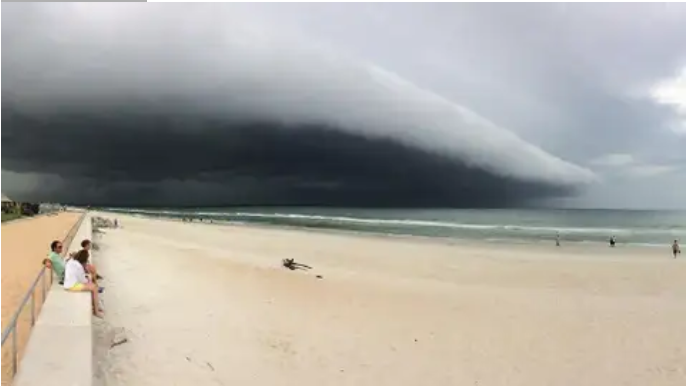
What type of cloud is this and with what type of thunderstorm is it associated?
This is a shelf cloud and it is associated with multi-cell thunderstorms
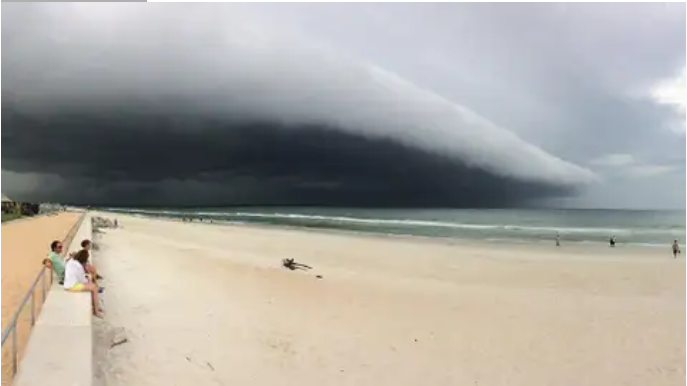
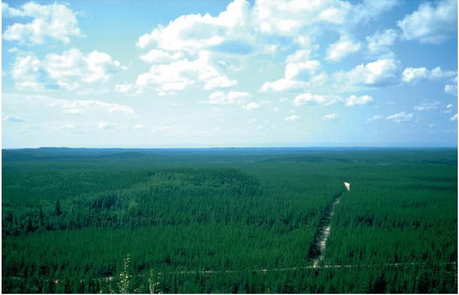
These are ______________ which have formed at the top of _______ The flattened cloud tops are indicative of the presence of an _______
These are fair weather cumulus clouds which have formed at the top of rising thermals. The flattened cloud tops are indicative of the presence of an elevated stable layer
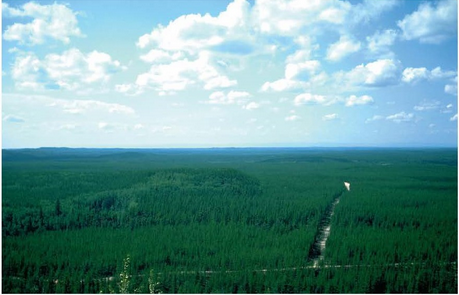
A super-cell thunderstorm _______ produces one or more of 1) very strong horizontal gusts 2) large _______ 3) strong _______
A super-cell thunderstorm always produces one or more of 1) very strong horizontal gusts 2) large hail 3) strong tornadoes
This stage of a single-cell thunderstorm is dominated by a continuous updraft
Cumulus stage
What is considered the "cloudless root" of cumulus clouds?
A thermal
Single-cell
Lasts less than one hour; ordinary
Multi-cell
Usually lasts more than one hour; a group of cells in various stages of development
Super-Cell
Lasts two hours or longer; almost always produces one or more of the extremes of convective weather
Thunderstorms are rooted in
Dry convection
In Chapter 5 we learned about convection as 1 of the 4 major causes of vertical motion in the atmosphere. What is a distinct version of this process?
A thermal
T/F - Strong downward currents in clouds enhance the growth rate of precipitation
FALSE
T/F - A thunderstorm is sometimes accompanied by lightning and thunder
FALSE
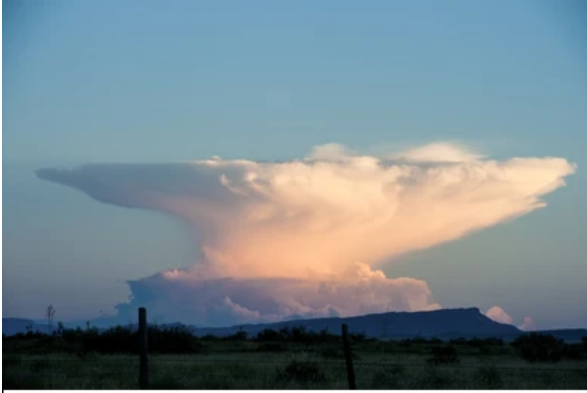
What type of cloud is this and with what type of thunderstorm is it associated?
This is an anvil cloud and it is associated with severe super-cell thunderstorms
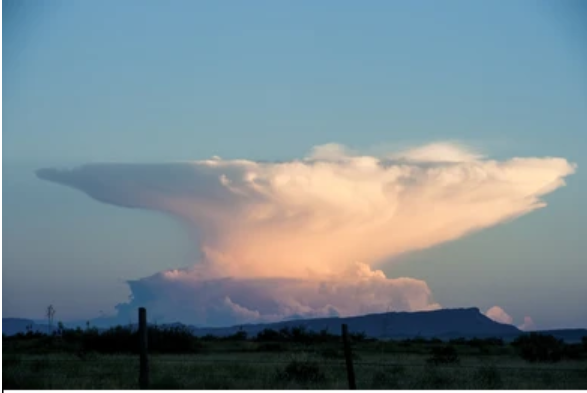
Strong tornadoes are associated with
Severe thunderstorms
What is the most dominant feature of a thermal?
The updraft
An airmass thunderstorm
May produce small hail and wind gusts that are less than 50 knots
“Ordinary”
Which of the following statements about Dust Devils are FALSE
TRUE - Dust devils rarely last longer than 4 minutes, although some longer reports have been received.
FALSE - Dust devils have a very clear and distinct internal circulation
TRUE - Dust devils have no preferred direction of movement; they move with the speed and direction of the average wind around them.
FALSE - Dust devils are a product of wet convection; they require the presence of CB or CU to form.
A large scale weather pattern must have two characteristics to produce lee wave activity
Wind speeds across the top of the mountains must be at least 20 knots
There must be a stable layer just above the mountain
Thermally driven local wind
Cold downslope wind
Externally driven local wind
Warm downslope wind
Valley breeze
Upslope wind
Mountain breeze
Downslope wind
Which of the following mountain and wind characteristics produce the largest amplitude lee waves?
Taller mountains
Winds in excess of 20 knots at the top of the mountain
The cause of a broken line of cumulus clouds along the shoreline during the afternoon in the summer is due to _______ caused by _______
The cause of a broken line of cumulus clouds along the shoreline during the afternoon in the summer is due to strong updraft caused by a land breeze front
The _______ the temperature gradient the _______ the pressure gradient, the _______ the thermally driven local wind
The greater the temperature gradient, the greater the pressure gradient, the stronger the thermally driven local wind
Which of the following are thermally driven local winds?
Valley Breeze
Cold Downslope Wind
Drainage winds are also called
Cold Downslope Winds
Cold downslope winds, also called _______ , are often weak due to the offsetting effect of _______ which is ______ by _______
Cold downslope winds, also called drainage winds, are often weak due to the offsetting effect of adiabatic heating which is warming by compression
Winds nearly ______________ to a ridgeline are more effective in the production of lee waves than winds nearly ______________
Winds nearly perpendicular to a ridgeline are more effective in the production of lee waves than winds nearly parallel
The characteristics of an _______ cold airmass moving over a warm surface are _______ clouds, turbulence, and good visibility. A stable airmass is most likely to have _______ air
The characteristics of an unstable cold airmass moving over a warm surface are cumuliform clouds, turbulence, and good visibility. A stable airmass is most likely to have smooth air
Thermally driven local winds blow from _______ to _______
Thermally driven local winds blow from cold to warm
Lee waves are most frequent in _______ months when ______________ activity is _______
Lee waves are most frequent in cooler months when extratropical cyclone activity is greater
Landing at an airport in a snow and ice covered area, will likely encounter?
Surface-based inversion
Match the weather phenomena with it's cause
Microbursts, Fronts and Shallow Lows, Jet Streams, Air Mass Wind Shear, Elevated Stable Layers
Microbursts - Low-level windshear
Fronts and Shallow Lows - Low-level windshear
Jet Streams - Clear Air Turbulence
Air Mass Wind Shear - Mountain Lee Wave
Elevated Stable Layers - Wind Shear
In Chapter 5 we learned about convection as 1 of the 4 major causes of vertical motion in the atmosphere. What is a distinct version of this process?
A thermal
Fluctuations in airspeed >25 knots is
Severe (turbulence)
Which frontal wind shear is characterized by low ceilings and poor visibility
Warm Fronts
Low-level wind shear will usually occur
After a cold front passes and before a warm front passes
Wind shear that develops near the ground at night with generally fair weather otherwise, will likely be
Airmass Wind Shear
Downbursts and microbursts are often caused by the ______________ of a thunderstorm
Downbursts and microbursts are often caused by the precipitation induced downdrafts of a thunderstorm
The Terminal Doppler Radar typically associated with Low level wind shear alerting systems uses a?
Narrow beam and greater power than standard Doppler
The horizontal dimensions of a microburst are?
Max of 2.2 NM (nautical miles)
T/F - It is okay for an aircraft to land or takeoff in the face of an approaching thunderstorm
FALSE
LLWS will occur _______ the cold front passes and _______ the warm front passes
LLWS will occur after the cold front passes and before the warm front passes
Strong wind shear occurs during ______________ of an extratropical cyclone
Strong wind shear occurs during the incipient stage of an extratropical cyclone
Match the turbulence with the level
Extreme, Severe, Moderate, Light
Extreme - a/c is violently tossed about and almost impossible to control
Severe - large, abrupt changes in altitude and/or attitude, a/c may be momentarily out of control
Moderate - causes changes in altitude and/or attitude but a/c remains under control
Light - slight erratic changes in altitude and/or attitude
T/F - The stronger the horizontal temperature gradient across the frontal zone, the weaker the wind shear
FALSE
In order to be considered low-level wind shear in aviation, the shear must occur
Below 2,000 ft. AGL and along approach path or initial climb path
If the wind direction changes over a given distance, the actual wind shear is ______________ than the change in the wind speed alone.
If the wind direction changes over a given distance, the actual wind shear is always greater than the change in the wind speed alone.
Wind velocity
This is a vector quantity that describes the horizontal motion of air in terms of wind direction and magnitude
Wind
The horizontal movement of air; air in motion relative to the surface of the earth
Low level wind shear
Wind shear below 2000’ AGL along the final approach path or along the takeoff and initial climb out path
Wind direction
Reported as the direction from which the wind is blowing
With a warm front, the most critical period for LLWS is _______ the front passage
With a warm front, the most critical period for LLWS is before the front passage
Wind shear
Difference in wind velocity (direction and/or speed) between two points divided by the distance between the points
Wind shear (refined) - (idk why but mangrum has two different definitions for “wind shear” so watch out for this on the test)
Wind shear (refined) - Change in wind direction and/or speed within a very short distance
Wind shear - Difference in wind velocity (direction and/or speed) between two points divided by the distance between the points
What generally determines the severity of wind shear across a frontal zone?
Horizontal Temperature Gradient
If LLWS is encountered on approach and the headwind increases or tailwind decreases, an aircraft can ______________ the runway
If LLWS is encountered on approach and the headwind increases or tailwind decreases, an aircraft can land beyond (overshoot) the runway
Total Wind Shear must consider?
Change in direction and velocity
Because of nighttime surface-based temperature inversions, expect wind shear whenever the wind speed between 2,000’ and 4,000’AGL is
At least 25 knots
The magnitude of turbulence depends upon not only weather but also ______________ and ______________
The magnitude of turbulence depends upon not only weather but also pilot response and aircraft design
T/F - The winds, wind shear and turbulence are weaker through and downwind of a mountain pass.
FALSE
What are examples of low-level turbulence?
Mechanical turbulence
Turbulence in fronts
T/F - An aircraft descending from the capping stable layer through a layer of CU into the dry convective layer below cloud base will encounter persistent LLT due to dry thermals in the convective boundary layer
TRUE
Which is the most important measurement with respect to turbulence?
Intensity
T/F - The growth of thermal turbulence is proportional to the distance from the ground.
TRUE
The greatest mechanical turbulence will occur when
The ground is flat and wind speeds are strong
When airflow is hindered by surface friction
T/F - Aviation turbulence is a state of the atmosphere, not based upon the response of the aircraft
FALSE
T/F - Over rough terrain, all fronts should be assumed to have moderate or greater turbulence, regardless of their speed
TRUE
The intensity of LLT ____________ with wind speed and _____________ of the terrain. Over rough terrain, moderate or greater LLT is likely when sustained winds exceed ______ knots, and severe turbulence can be expected with winds of 40 knots or more
The intensity of LLT increases with wind speed and steepness of the terrain. Over rough terrain, moderate or greater LLT is likely when sustained winds exceed 25 knots, and severe turbulence can be expected with winds of 40 knots or more.
Clyclonic flow in the northern hemisphere is characterized by
Low pressure
Counterclockwise rotation
Where is the most likely location for mechanical turbulence with respect to ridgelines?
Just past the peak of the ridgeline, on the leeward side
Fart
ass
In a coastal area with a beach, what would be the most likely cause of mid-morning to mid-day thunderstorms?
Sea Breeze Front
Strong wind shear occurs during _________ of an extratropical cyclone
Strong wind shear occurs during the incipient stage of an extratropical cyclone
If LLWS is encountered on approach and the headwind decreases or tailwind increases, an aircraft can the runway
If LLWS is encountered on approach and the headwind decreases or tailwind increases, an aircraft can land short of (undershoot) the runway
What causes air to blow from the sea to the land (sea breeze)?
Low pressure over the land
The primary cause of a Valley Breeze is _________
The primary cause of a Valley Breeze is horizontal temperature gradient
During departure under conditions of suspected LLWS, a sudden ___________ in headwind will cause a ________ in airspeed equal to the __________ in wind velocity
During departure under conditions of suspected LLWS, a sudden decrease in headwind will cause a loss in airspeed equal to the decrease in wind velocity
LLWS in airmass tends to __________ with sunrise as the ground heats up
LLWS in airmass tends to decrease with sunrise as the ground heats up
You are approaching an airport in a coastal area near a beach. The expected ETA is right at sunrise. What might the pilot be aware of regarding winds?
Land Breeze will be at its most intense
If LLWS is encountered on takeoff and headwind decreases or tailwind increases, the angle of climb and climb rate ___________
If LLWS is encountered on takeoff and headwind decreases or tailwind increases, the angle of climb and climb rate decrease
The presence of cumulus clouds and turbulence on the lee side of a ridgeline or peak, in the spring or summer, indicates that a _________ is likely present
The presence of cumulus clouds and turbulence on the lee side of a ridgeline or peak, in the spring or summer, indicates that a valley breeze is likely present